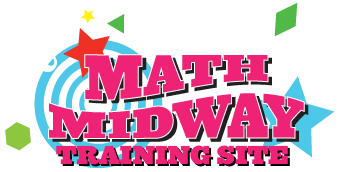Scroll down to see full description and guide.
Make sure that visitors to this exhibit understand that this is not an ordinary maze. There is a special rule that at each corner you can go straight or turn right, but never turn left. Also, you are not allowed to turn around (which would be a way around the first rule). These rules make the maze much more difficult than it looks.
Young children may ignore the rules. Don't worry about it. (Let them have fun.)
For older kids and adults, you can point out the picture on the sandwich board, with the two mazes. The more complicated-looking maze reveals the structure of the puzzle: as a person travels through the maze, both the position and direction of travel are important. In the picture, the two directions of travel are separated into two different paths, with arrows, showing the allowed turns for each.
Some people will want to solve the maze by looking at the end and tracing a route backwards to the start. This is perfectly fine -- always encourage people to try different problem-solving strategies.
If you want to provide a hint, getting into the small square near the center is part of the solution.
Visitors may ask about "graph theory", which is mentioned on the sign. The word "graph" is used in two different ways in mathematics. One is the familiar use, meaning a plot of points or a function. In this case, "graph theory" refers to a more abstract branch of mathematics dealing with networks and relationships. Graph theory is a topic that people usually don't study before college.


